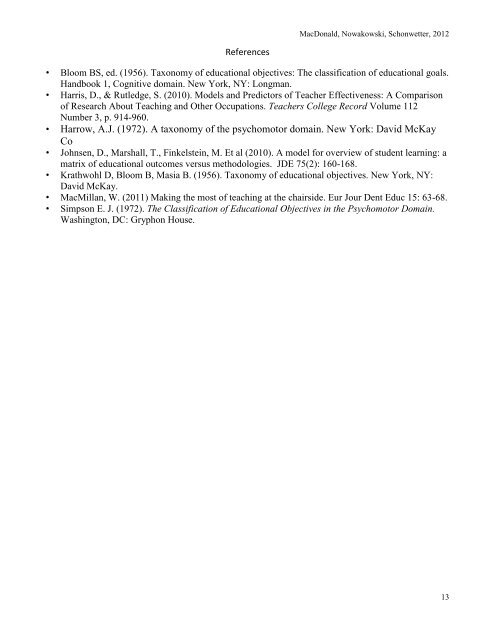Actively Engaging Students in Affective, Cognitive, & Psychomotor ...
Actively Engaging Students in Affective, Cognitive, & Psychomotor ...
Actively Engaging Students in Affective, Cognitive, & Psychomotor ...
Create successful ePaper yourself
Turn your PDF publications into a flip-book with our unique Google optimized e-Paper software.
References<br />
MacDonald, Nowakowski, Schonwetter, 2012<br />
• Bloom BS, ed. (1956). Taxonomy of educational objectives: The classification of educational goals.<br />
Handbook 1, <strong>Cognitive</strong> doma<strong>in</strong>. New York, NY: Longman.<br />
• Harris, D., & Rutledge, S. (2010). Models and Predictors of Teacher Effectiveness: A Comparison<br />
of Research About Teach<strong>in</strong>g and Other Occupations. Teachers College Record Volume 112<br />
Number 3, p. 914-960.<br />
• Harrow, A.J. (1972). A taxonomy of the psychomotor doma<strong>in</strong>. New York: David McKay<br />
Co<br />
• Johnsen, D., Marshall, T., F<strong>in</strong>kelste<strong>in</strong>, M. Et al (2010). A model for overview of student learn<strong>in</strong>g: a<br />
matrix of educational outcomes versus methodologies. JDE 75(2): 160-168.<br />
• Krathwohl D, Bloom B, Masia B. (1956). Taxonomy of educational objectives. New York, NY:<br />
David McKay.<br />
• MacMillan, W. (2011) Mak<strong>in</strong>g the most of teach<strong>in</strong>g at the chairside. Eur Jour Dent Educ 15: 63-68.<br />
• Simpson E. J. (1972). The Classification of Educational Objectives <strong>in</strong> the <strong>Psychomotor</strong> Doma<strong>in</strong>.<br />
Wash<strong>in</strong>gton, DC: Gryphon House.<br />
13



